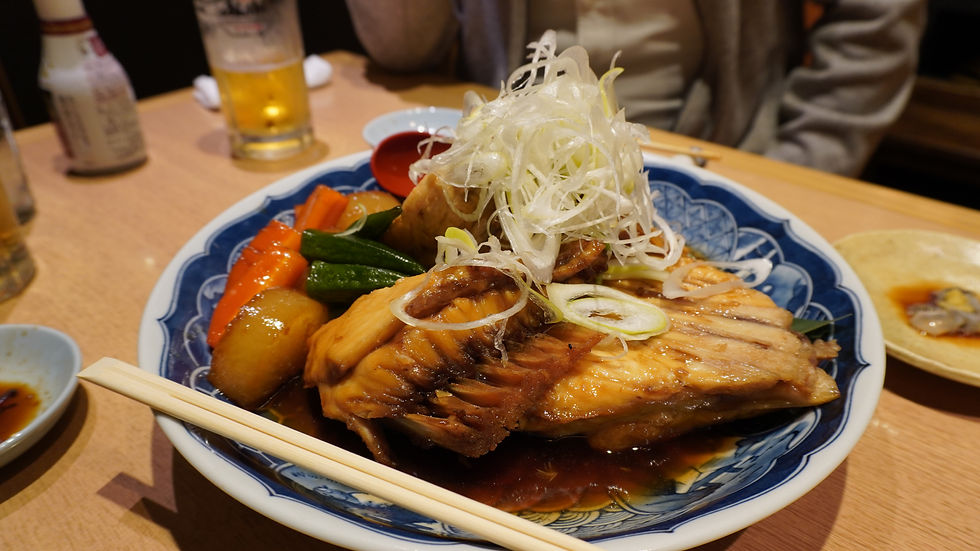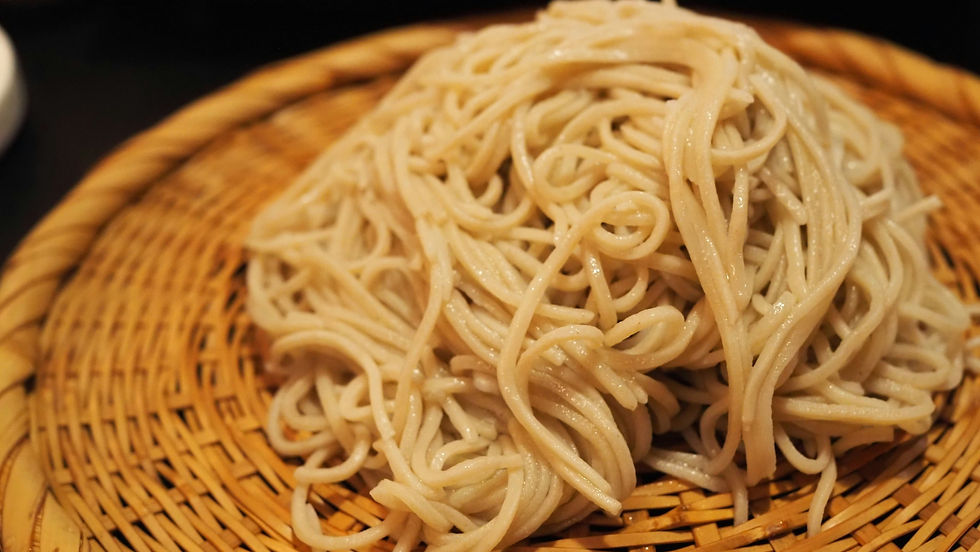Can You Eat Gluten Free in Tokyo? A Complete Travel Guide
- Daisy Stone
- Jul 8
- 6 min read
Updated: Nov 22
Picture this: you're planning the trip of a lifetime to Tokyo, ready to dive into one of the world's most celebrated food scenes. Then reality hits – how will you navigate this culinary paradise with gluten intolerance or celiac disease?

You may be surprised to learn that you can not only eat gluten free in Tokyo but eat incredibly well in one of the world's top culinary capitals.
Consider this post a complete gluten-free Tokyo travel guide, designed so you can enjoy amazing Japanese cuisine without facing the repercussions of an accidental glutening.
Traveling Gluten Free: A Guide to Prepping for your Tokyo Trip
Making preparations before traveling will make your Tokyo trip so much more enjoyable in the long run. Trust me, you’ll thank yourself later! Here are the top things to prepare before your trip:

Bring Your Own (Gluten-Free) Soy Sauce

Most, if not all, soy sauce you encounter at restaurants in Japan will contain wheat. My advice: pack your own bottle of gluten-free tamari, or small disposable tamari packets with you.
In my experience, restaurants will have no problem with you using your own soy sauce. If they do have an issue with this (which is rare) that leads to my next essential tip…
Print Out Gluten-Free Translation Cards
It can be incredibly difficult to explain your need for a gluten-free meal in Japan without speaking Japanese. Even if you've memorized a few key phrases, when it comes to something as important as avoiding an ingredient that makes you sick, it's best to be as clear as possible.
That's why, bringing gluten-free translation cards with you to show restaurant staff what you can and cannot eat is a must.

These cards explain your dietary restrictions in Japanese and list common ingredients to avoid.
You can find printable versions online to print out for your wallet or purse.
I recommend this one from celiactravel.com.
Learn the Essential Kanji
While translation cards are helpful, knowing how to spot ingredients on food packages or menus can be a lifesaver.

No need to spend years learning Japanese, I’ve got you covered with this cheat sheet. Here are the key ingredient names to look out for:
小麦 (Komugi)・Wheat
大麦 (Omugi)・Barley
ライ麦 (Rai Mugi)・Rye
麦芽/モルト (Bakuga/Moruto)・ Malt
全粒粉 (Zenryufun)・Whole wheat flour
グルテン (Guruten)・Gluten
And here are some more common ingredients to watch out for in Japanese products:
醤油 (Shoyu)・Soy sauce. Unless specifically stated, all soy sauce in Japan will usually contain wheat
味噌 ・Miso. Same as soy sauce, most miso in Japan will contain some wheat, although there are varieties that are composed of pure soy beans. Ask before eating!
酢 (Su)・Vinegar. Steer clear of vinegar unless it is 米酢 (Kome Su), or rice vinegar.
小麦澱粉/小麦でん粉 (Komugi denpun/ komugi denko)・ Wheat starch is found in a variety of packaged foods
水飴/水あめ (Mizuame)・Starch syrup is typically found in sweets and is sometimes made using barley.
Being able to spot these characters will save you from a potentially uncomfortable situation. It's especially helpful when shopping at convenience stores or supermarkets for snacks.
Research in Advance
Before your trip, I highly recommend downloading the FindMeGlutenFree app.
You can search by neighborhood to discover gluten-free friendly restaurants which will save a lot of stress during your day to day excursions.
Take some time to map out potential restaurants near your hotel and major attractions you plan to visit.

Naturally Gluten-Free Japanese Foods
One of the best things about Japanese cuisine is that many traditional dishes are naturally gluten free or can be easily modified. Here are some that have never failed me when I am in a pinch:
Yakiniku and Yakitori (Salt-Seasoned)
Looking to experience Japanese izakaya (bar) culture? Then yakiniku (Japanese bbq) and yakitori (grilled chicken on skewers) are a must-try in Tokyo!

Just ask for yours to be seasoned with salt (shio) rather than the sweet soy sauce glaze (tare), and you are on your way to enjoy one of Tokyo’s best dishes!
Onigiri
Onigiri are rice balls with a variety of fillings and can be found in every convenience store throughout Japan. You can also order them at most izakaya, or Japanese pubs.

Look for simple fillings like umeboshi (pickled plum), salmon, or the plain salt seasoned onigiri. Avoid anything that lists soy sauce or vinegar made from wheat.
Traveling with dietary restrictions? Japan Food Travels specializes in building food-safe, gluten-free, and allergy-aware itineraries so you can eat confidently and enjoy Tokyo without stress. Discover JFT’s custom travel planning options.
Sushi and Sashimi

Sushi can be a good option if you're careful. The rice itself is gluten free, but you'll need to:
Bring your own tamari for dipping
Avoid unagi (eel) which is almost always glazed with a wheat-containing sauce
Be cautious with any marinated items like ikura (salmon roe) as they usually are marinated in soy sauce
Ask for your sushi to be prepared without any sauces or glazes

Sashimi (sliced fish) is an even safer choice. Donburi (rice bowls topped with fish) are also great, as the rice is usually unseasoned.
Pure Buckwheat Soba
Traditional soba noodles are made from 100% buckwheat flour, which is naturally gluten free. However, many restaurants mix wheat flour into their soba for texture and a slightly lighter flavor.

Look specifically for restaurants making "ju-wari soba" (十割蕎麦) made from pure buckwheat and double-check with your translation card to be safe.
Traditional Japanese Desserts
Traditional mochi (pounded rice cakes) and daifuku (mochi filled with sweet fillings like red bean paste and fruit) are made from glutinous rice, which, despite its name, doesn't contain gluten at all.

Mochi and daifuku are available at speciality shops and department store food halls throughout Tokyo. My personal favorite is ichigo daifuku, mochi filled with red bean paste and topped with a fresh strawberry.
Top Gluten-Free Restaurants in Tokyo
Worried you’ll miss out on Japanese food favorites like ramen or karaage? Don’t be. These dedicated gluten-free spots in Tokyo have got you covered:
This hidden gem in Tokyo’s Harajuku neighborhood specializes in gluten-free udon noodles made from brown rice that taste just like the real thing.
Try the classic niku udon topped with delicate slices of beef, or go for something a bit more fusion with their curry udon.

Their dedicated gluten-free kitchen means zero cross-contamination concerns. Don't miss their tempura, which is also gluten free – a rare treat in Tokyo!
Did you know that Japan is famous for their bakeries? Unfortunately, standard Japanese bakeries are off limits if you're gluten intolerant.

However, there are some hidden gluten-free bakery gems to be found.
My favorite gluten-free bakery is RICEHACK in Tokyo's trendy Omotesando neighborhood, which serves up a variety of supremely fluffy and moist rice based Japanese baked goods like Japanese curry bread (Kare Pan.)
Come here early for their famous gluten-free pizza. But be warned, they sell out quickly!
Shinbu Sakiya Ramen is serving up the best gluten-free ramen in Tokyo. This shop, located in the heart of Shibuya, specializes in ramen from Japan’s northernmost island of Hokkaido.

Choose from gluten-free miso, spicy miso, shoyu (soy sauce), and shio (salt) based ramen. They also offer gluten-free Japanese fried chicken and gyoza!

This cozy café specializes in eye-catching, gluten-free fluffy Japanese pancakes in a variety of flavors. It’s an absolute must-try. Keep an eye out for a full review coming soon!
Common Questions About Eating Gluten-Free in Tokyo
Is soy sauce in Japan gluten-free?
No, unfortunately most standard Japanese soy sauces are made from a mixture of soybeans and wheat. This is why bringing your own gluten-free tamari is recommended.
Is tempura gluten-free?
Traditional tempura batter is made using wheat flour, so it's not gluten-free. However, some specialized restaurants like Esoragoto Udon mentioned above make gluten-free versions using rice flour.
Are rice noodles common in Japan?
Unlike in other Asian countries, rice noodles aren't very common in Japanese cuisine. Most Japanese noodles like ramen and udon contain wheat, with the exception of 100% buckwheat soba.
How do I say "I have celiac disease" in Japanese?
The phrase is "Watashi wa seliakku-byō desu" (私はセリアック病です). However a detailed translation card is more effective to communicate what you cannot eat as celiac disease is not widely understood or common in Japan.
Embracing Gluten-Free Tokyo
With proper preparation and knowledge of safe options, you can still enjoy the culinary adventure of a lifetime while gluten free.

I've found that most restaurant staff in Tokyo are incredibly accommodating once they understand your needs. Japanese culture places high value on hospitality, and many places will go out of their way to ensure you have a safe and enjoyable meal. So, get out there and enjoy your trip!








Comments